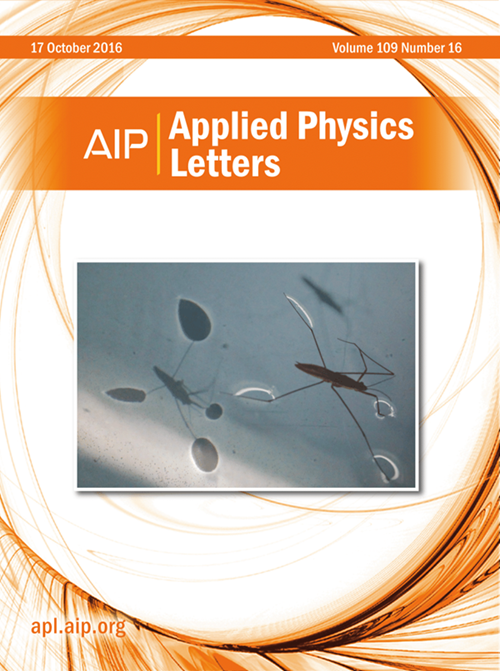Controlled polarity inversion in GaAs/Ge/GaAs{111} heterostructures
IF 3.5
2区 物理与天体物理
Q2 PHYSICS, APPLIED
引用次数: 0
Abstract
We have fabricated the GaAs/Ge/GaAs heterostructures on the {111}-oriented substrates using molecular-beam epitaxy for quasi-phase matching applications in nonlinear optics. The nonlinear optical coefficient of GaAs is beyond that of conventional LiNbO3, enabling more efficient generation of entangled photon pairs via parametric downconversion. We show that GaAs films with either (111)A- or (111)B-orientation could be grown on the Ge/GaAs{111} substrates, regardless of the polarity of the initial substrates; the (111)A- and (111)B-oriented GaAs overlayers were grown when the surfaces of Ge interlayers on the GaAs{111} substrates were terminated with 1 monolayer (ML)-Ga and 1 ML-In, respectively. Both (111)A- and (111)B-oriented GaAs overlayers have atomically flat surfaces and are almost free of defects, such as rotational twins and stacking faults. The present results provide a promising way to improve the efficiency of nonlinear optical processes in quasi-phase matching devices.GaAs/Ge/GaAs{111}异质结构的可控极性反转
我们利用分子束外延技术在{111}取向衬底上制备了GaAs/Ge/GaAs异质结构,用于非线性光学中的准相位匹配应用。砷化镓的非线性光学系数超过了传统的LiNbO3,可以通过参数下转换更有效地产生纠缠光子对。我们发现,无论初始衬底的极性如何,都可以在Ge/GaAs{111}衬底上生长(111)A-或(111)b取向的GaAs薄膜;当GaAs{111}衬底上的Ge中间层表面分别以1 ML- ga和1 ML- in终止时,生长出(111)A和(111)b取向GaAs覆盖层。(111)A-和(111)b取向GaAs覆盖层都具有原子平面,并且几乎没有缺陷,例如旋转孪晶和层错。本研究结果为提高准相位匹配器件中非线性光学过程的效率提供了一条有希望的途径。
本文章由计算机程序翻译,如有差异,请以英文原文为准。
求助全文
约1分钟内获得全文
求助全文
来源期刊

Applied Physics Letters
物理-物理:应用
CiteScore
6.40
自引率
10.00%
发文量
1821
审稿时长
1.6 months
期刊介绍:
Applied Physics Letters (APL) features concise, up-to-date reports on significant new findings in applied physics. Emphasizing rapid dissemination of key data and new physical insights, APL offers prompt publication of new experimental and theoretical papers reporting applications of physics phenomena to all branches of science, engineering, and modern technology.
In addition to regular articles, the journal also publishes invited Fast Track, Perspectives, and in-depth Editorials which report on cutting-edge areas in applied physics.
APL Perspectives are forward-looking invited letters which highlight recent developments or discoveries. Emphasis is placed on very recent developments, potentially disruptive technologies, open questions and possible solutions. They also include a mini-roadmap detailing where the community should direct efforts in order for the phenomena to be viable for application and the challenges associated with meeting that performance threshold. Perspectives are characterized by personal viewpoints and opinions of recognized experts in the field.
Fast Track articles are invited original research articles that report results that are particularly novel and important or provide a significant advancement in an emerging field. Because of the urgency and scientific importance of the work, the peer review process is accelerated. If, during the review process, it becomes apparent that the paper does not meet the Fast Track criterion, it is returned to a normal track.
 求助内容:
求助内容: 应助结果提醒方式:
应助结果提醒方式:


